Versailles: A Visit to the King’s Private Apartments, Part 2
In the late afternoon of the first day of my visit to Versailles, I went along to the ticket office of the Chateau to buy my ticket for the next day, including a guided tour of the Private Apartments. There were various tours in several languages, but the young woman behind the counter flatteringly recommended that I take the French language tour at 10:30, on the grounds that it was the most thorough one. I duly purchased a ticket and wandered off in the rain — the weather was relentlessly wet throughout my visit — to find my dinner.
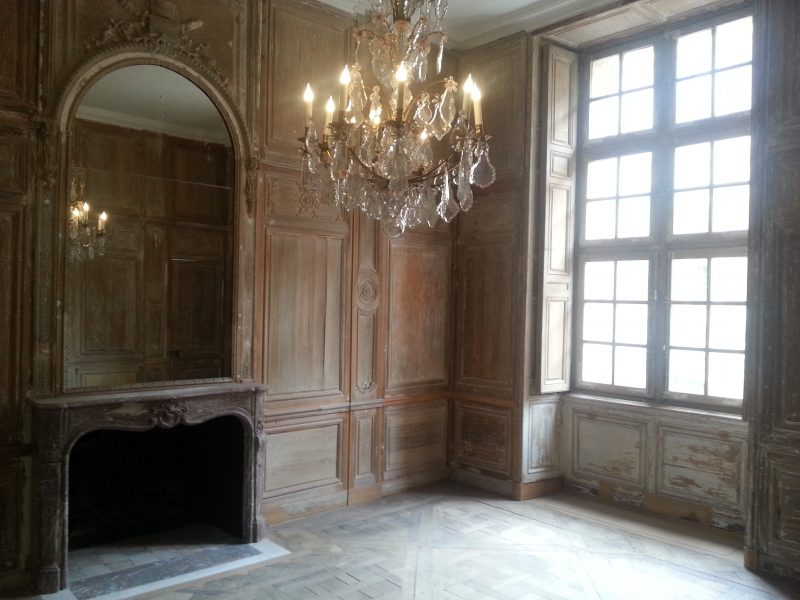
Semi-restored room in the ticket wing. My inner interior decorator sees some sleek Italian sofas and striking contemporary art in here.
All but skipping with excitement, I turned up the following morning at the designated entrance for the Private Apartments tour. This entrance is on the north side of the Cour Royale (the Royal Court), the great courtyard that precedes the Cour de Marbre (the Marble Court) at the heart of the palace. A uniformed man checked my ticket and waved me inside. A young woman in a smart black pantsuit and a headset then asked me which tour I was there for, and directed me into an adjoining salon. This turned out to be the holding tank for imminent tours. It retained its 18th century boiserie, but was furnished with sleek contemporary furniture, which I’m tempted to say was by Philippe Starck, but I’m not sure. Another pant-suited young lady appeared and gave me a pair of earphones. I nearly protested that I hadn’t asked for an audio guide, but held my peace. All became clear when the actual guide appeared, a brisk, middle-aged Frenchwoman. She instructed us to put in our earbuds and see if we could hear her on the audio system that was connecting us. A very sensible system, this. Nothing is more annoying on a guided tour than straining, and failing, to hear what the guide is saying. We were a group of about 15 or 20. As far as I could tell, I was the only non-francophone apart from a young woman from Brazil who was studying art history in Paris, which I know because we had a chat after the tour. In fact, it turned out that she was taking a course on museology and asked me if I would oblige her by taking a short survey about my Versailles experience. I obliged, of course.
The guide, whose name, unfortunately, I can’t recall, led us back out into the Cour Royale and towards the Cour de Marbre, and then turned right into a door which she unlocked with a key that she fished out of her coat pocket. We found ourselves in a vestibule to which we would return at the end of the tour. Then we went up a staircase and into the first room of the Private Apartment, namely the antechamber. Agog at the sights, I didn’t at first register that I could take photographs, so, unfortunately, there is no photo of the antechamber. (By the way, I’m trying to use only my own photographs for this blog. You should assume that all the photos you see are original unless I say otherwise in the captions.) I remember nothing about it, except that the guide told us that the courtiers had a special verb for waiting around in antechambers: faire antichambre, or antechambering.
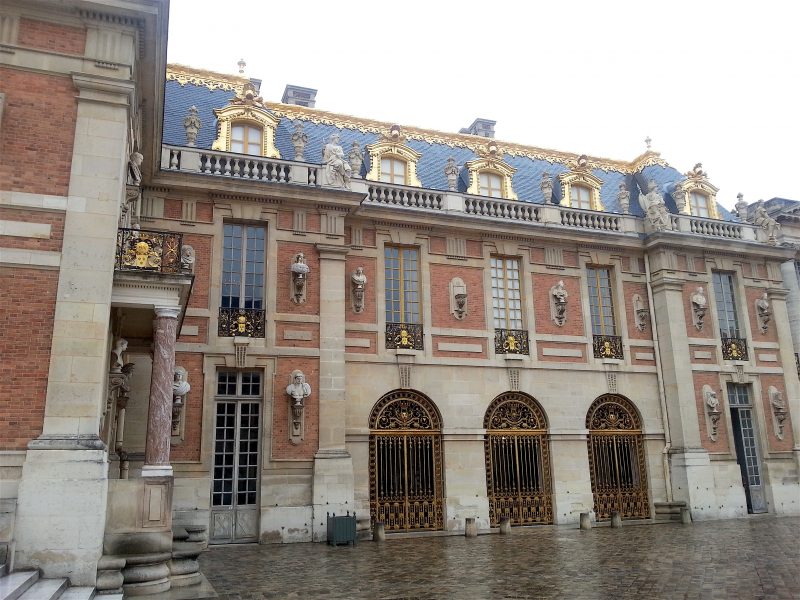
The Cour Royale where it meets the Cour de Marbre. I can’t recall which one exactly, but the guide took us through one of the arched gates, or perhaps it was the grey door at the far right.
From the antechamber we passed into one of the most famous rooms of the Chateau: the Salon de la Pendule (the Clock Chamber). It’s named eponymously for the astounding astrological time piece that stands on a stepped marble plinth at one of the room. In the centre of the room stands an equestrian statue in bronze of Louis XV himself.
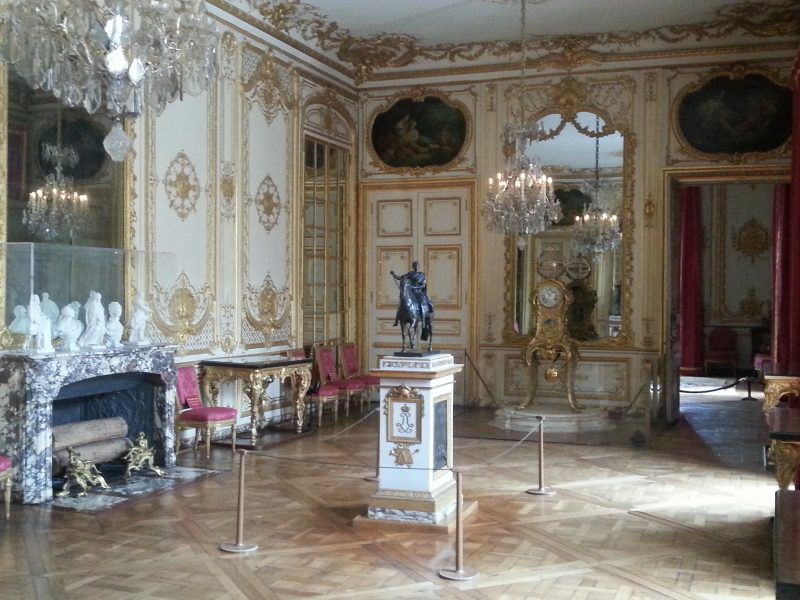
The Salon de la Pendule, named for the great clock at the far end of the room.
I remember the guide telling us that the clock is the original one, which is remarkable because most of the furnishings that we see at Versailles today are NOT the originals. Nearly all the Chateau’s contents were auctioned off under the First Republic (1792-95). Some have been bought back and re-installed. In other cases, rooms have been furnished with period pieces that are authentic, but which had been commissioned for the royal family’s other homes. Examples of this kind of substitution will be seen in a future post about the rooms of Mesdames, the daughters of Louis XV.
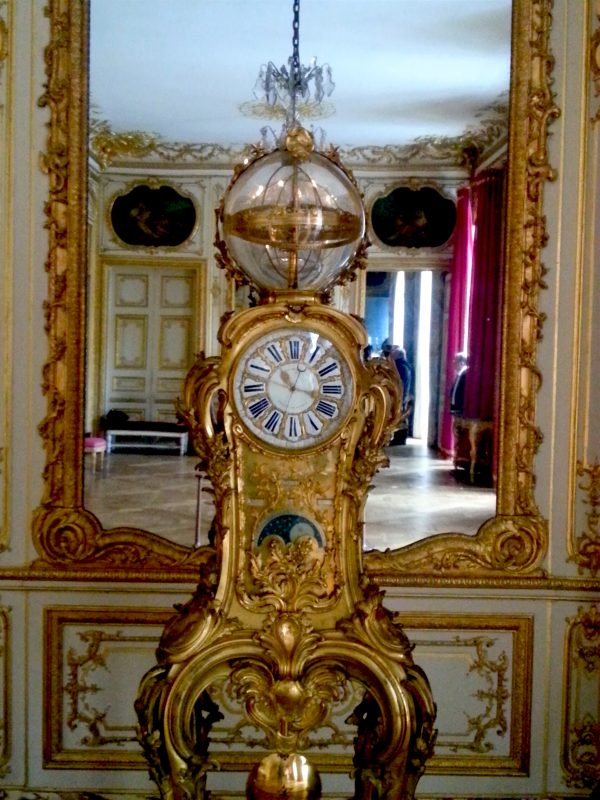
The great clock, one of the few objects at Versailles that is original to its room.
The next room was the King’s Bedroom. This room, as explained in the previous post, was created for Louis XV, who disliked sleeping in the vast, formal King’s Bedroom in the State Apartments. He also had another, even more private bedroom in the Petits Cabinets on the top of the palace. If you’re counting, this means that Louis XV had a total of 3 bedrooms in the Chateau! The actual bed in this room was not visible when I was there. It was screened away behind a curtain. Perhaps it was under restoration?
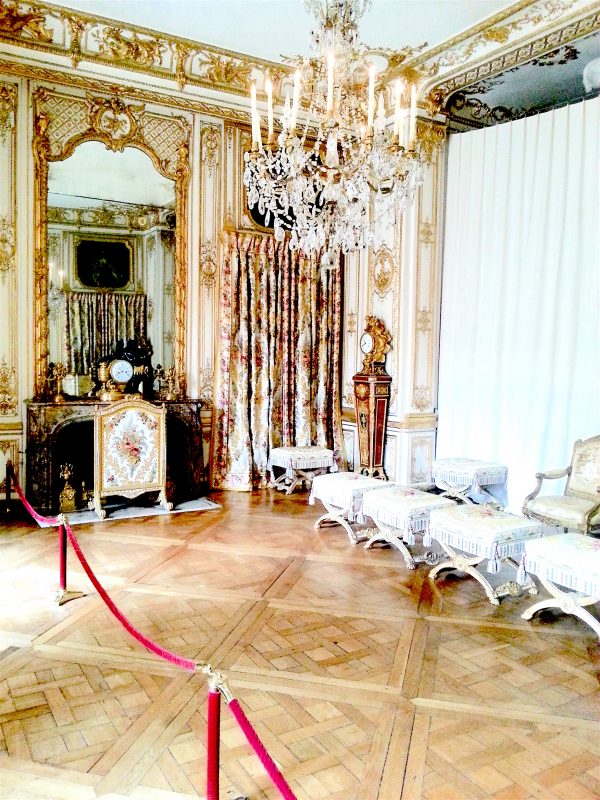
The King’s private bedroom. Note the curtain.
The subsequent room was the Cabinet du Roi, known as the King’s Study in English, which is at the corner of the Cour de Marbre and the Cour Royale, as shown above. The colour scheme in this room is red and gold. The effect is suitably magnificent. We didn’t get the full effect, though, because the room is kept quite dim. It also contains possibly the most celebrated piece of furniture in the entire Chateau, possibly of the Rococo period as a whole.
This, of course, is the King’s desk. Commissioned by Louis XV in about 1760, it was not delivered until 1769. It’s the masterwork of the great furniture-maker Riesener of Paris. A roll-top secretary, it was a state of the art piece of furniture in its day. Note the built-in candelabras. It also contained numerous secret drawers and compartments. It, too, is one of the few pieces of original furniture in the Chateau. Legend has it that the King always carried the key to one of the secret compartments on his person.
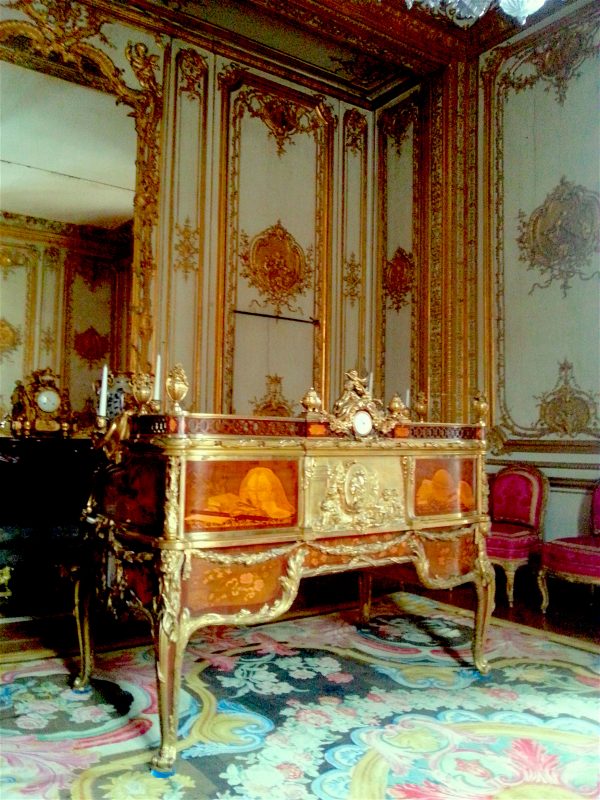
The King’s desk, another of the rare original items in the Chateau.
Behind the King’s Study were several small rooms. I believe one of them was a servant’s room. The King’s loo was another of them.
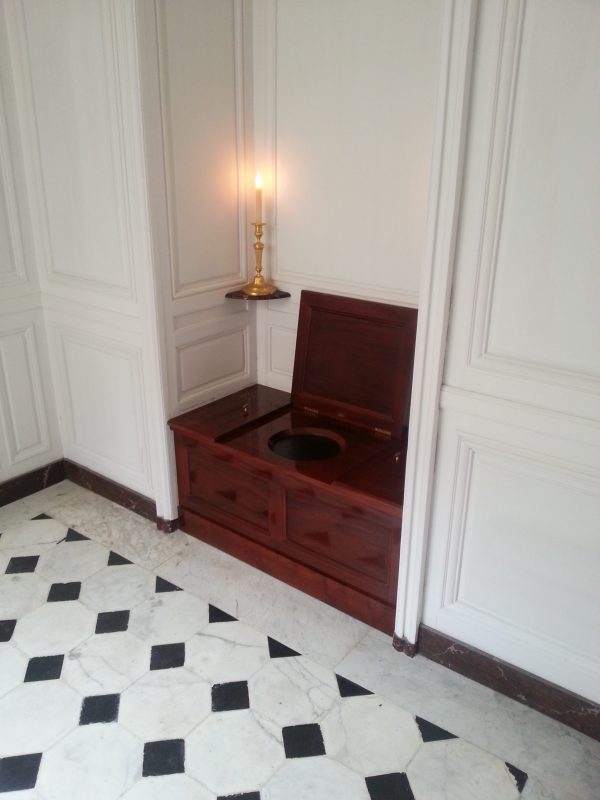
The King’s loo.
A more significant room was Louis XV’s inner study, AKA the dispatch room, where the guide told us he received his spies and confidential informers. Louis conducted a secret foreign policy, which often seems to have been at variance with the official one that his Minister of Foreign Affairs was conducting. The Minister, of course, was not in on the secret. One wonders if this was how Canada was lost.
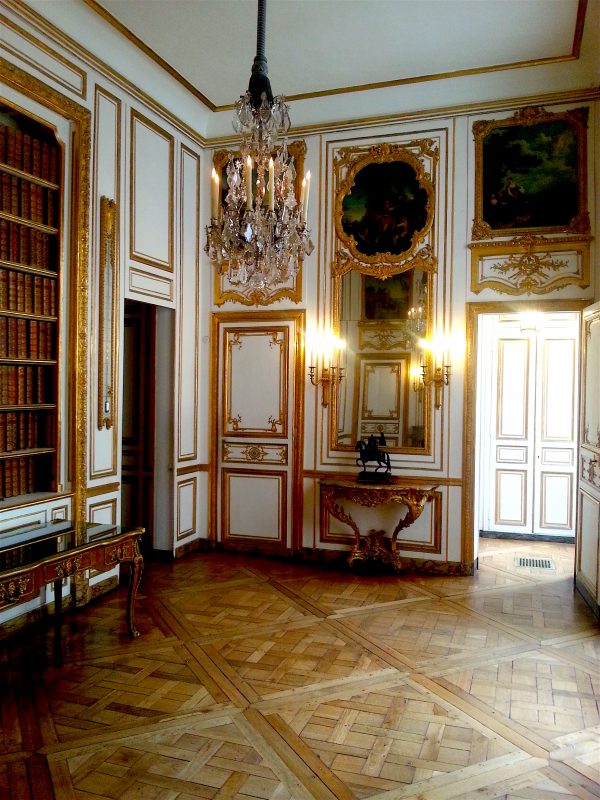
The inner study or dispatch room where Louis XV is said to have received his spies’ reports.
There was another room after this, one with a a number of paintings, but I don’t remember it clearly and for some reason I only photographed the ceiling. I missed the description of it because I had lingered in the inner study and tuned out the guide’s commentary.
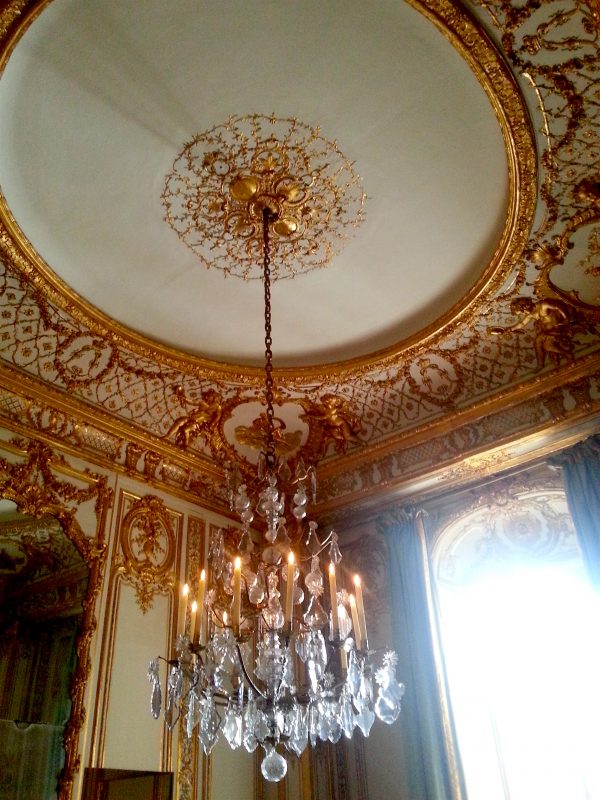
The ceiling of the nameless room.
The next room I remember very clearly and I listened very carefully to the guide’s explanation. This was the King’s library. This is the only room significantly altered by Louis XVI, who otherwise left his grandfather’s rooms untouched. It is thus the only room in the Private Apartment decorated in what we now call Louis XVI style, with straight, clean lines.
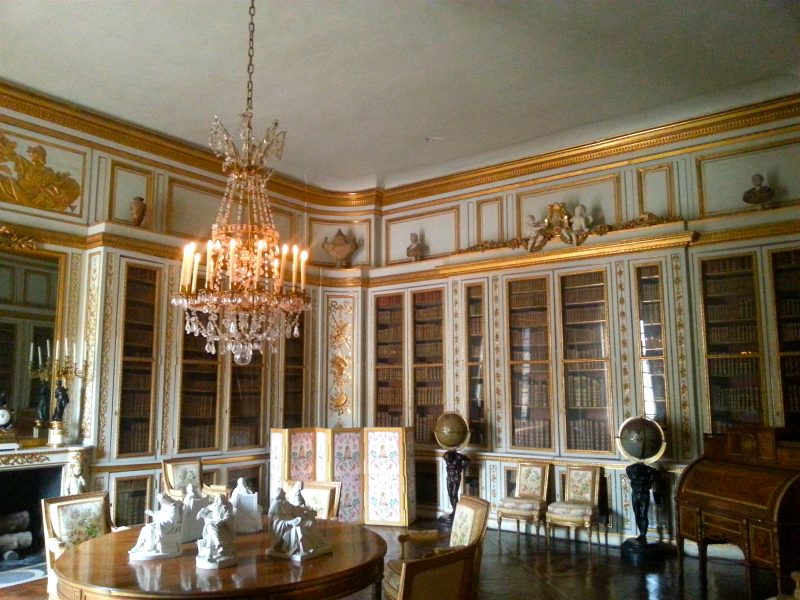
Louis XVI’s library, the only room of his grandfather’s that he completely changed.
The following room, the dining room, is one of the largest in the Petits Appartements.
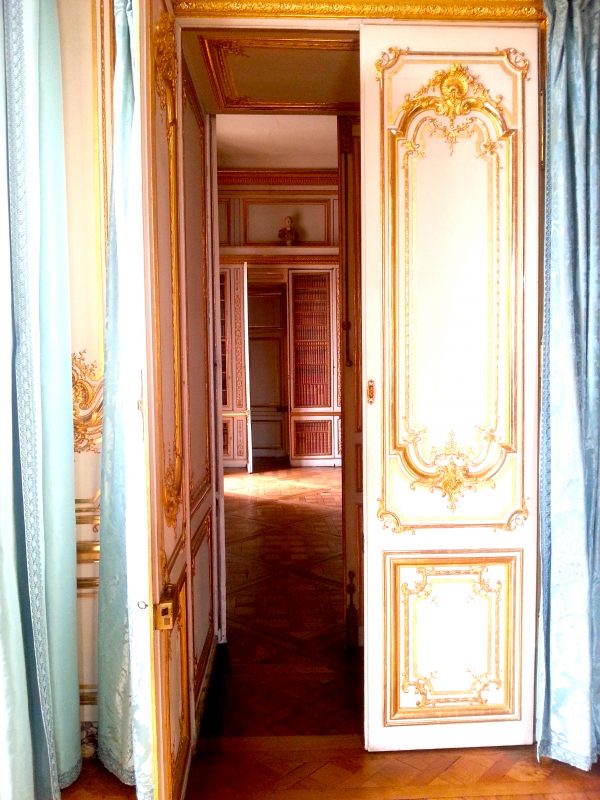
Looking back from the dining room into the library.
This room was groundbreaking in its time. Why? Dining rooms were not really a feature of houses before this time, and hadn’t been at Versailles, either. Meals were served on folding or trestle tables set up in any room chosen for the occasion. Royalty, of course, ate alone or with a few family members while everyone else stood around silently — unless a royal personage spoke to someone — and watched them. Such was the case for the King’s formal meals in the State Rooms. Louis XV, however, conceived the notion of dining informally with his friends amid general conversation. In short, he wanted dinner parties. Accordingly, a large table was installed in this room and everyone sat down and ate together. Compared to the theatrical performances that were the King’s public dinners, the intimate dinners here — up to 30 people may have been present, of course — must have seemed wonderfully casual and relaxed to the lucky few who were invited. Thirty guests may seem like a lot, but bear in mind that there were thousands of courtiers at Versailles and only a tiny percentage would ever have been invited here.
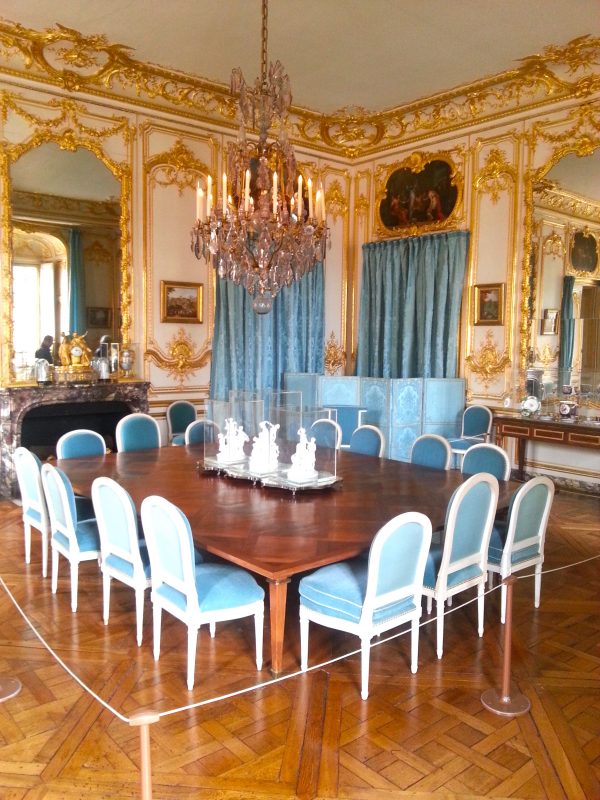
The dining room. I think the guide said the table dates from Louis XVI’s reign.
A sign of this room’s perceived informality at the time is that the food was served on porcelain. Royalty had traditionally eaten off gold or silver, called ‘plate’. Of course, the porcelain used here is now considered priceless.
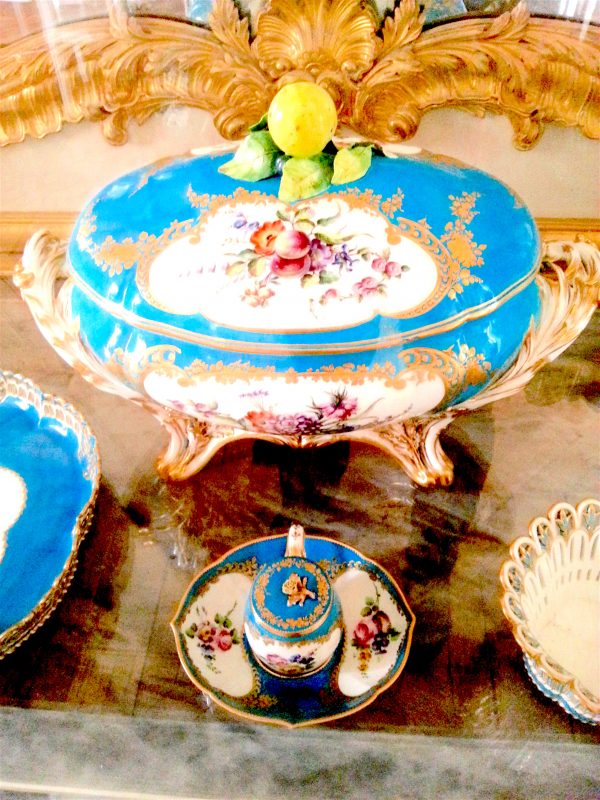
Porcelain under glass in the dining room.
Beyond this room was a pair of game rooms. Card playing was a major pursuit at Versailles, and everyone from the King on down indulged. For some reason, I didn’t photograph these rooms.
The tour of the Private Apartment ended at this staircase.
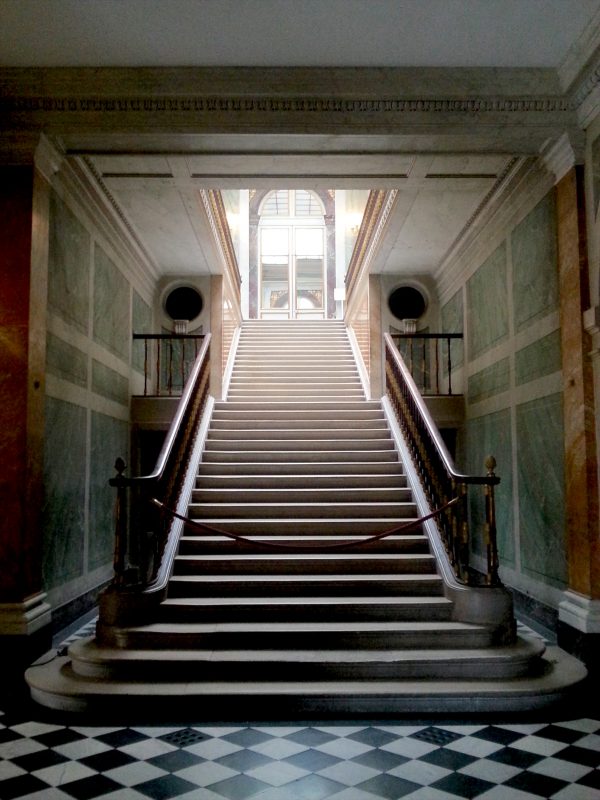
The tour ended here. The Private Apartments are upstairs to the left.
Well, actually, it continued to the opera house, but we’ll leave that for another time.
My memory may be faulty. There was so much to take in and I was too busy taking photographs to make notes. If you’ve spotted any errors or omissions, do give me some gentle correction in the comments. I’d also love to hear about your experience of visiting the Petits Appartements!







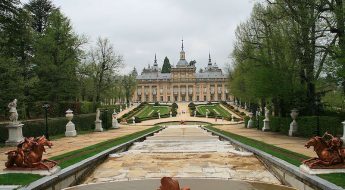
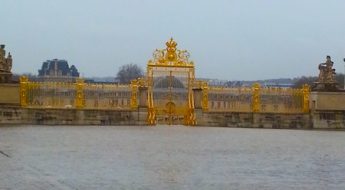








Thanks for your information on the guided tour! There is lot to read about the French history from your posts. I am planning to visit Versailles this year with my family and your post has confirmed that this guided tour is indeed worth visiting. But I am confused how to continue with the rest of the castle tour. Does that end of tour at the stairs lead to Hall of mirrors etc. or does it sends out the exit and start at the entrance A again for the castle? Your help is very much appreciated.
Dear Preeti,
I’m delighted to hear that you’ve find my posts useful.
If memory serves, you end up back in the courtyard after the tour. From there, you can go through the doors on the ground floor of the Cour de Marbre, passing under the King’s bedchamber and into the garden, or you can enter the other part of the Château through a door on the south side of the courtyard. I can re-confirm this information when I re-visit Versailles in early April.
Thanks for your question,
David Gemeinhardt
Thank you for responding, David. We plan to travel in May and hope I can gather more information by then. Enjoy your April visit:)